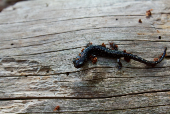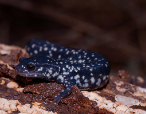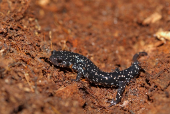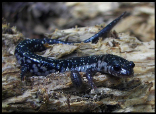Southeastern Slimy Salamander (Plethodon grobmani)
Description: P. grobmani's length snout to the base of the tail is 1.96 inches with a tail length of 2.41 inches. Body width is 0.32 inches. Skin coloration is black. The back has scattered gold dots and the sides have large grey dots.
Habitat: Its natural habitats are steephead valleys, maritime forests and bottomland hardwood forests.
Range: It is endemic to the United States, where it is distributed in the Southeastern United States from southern Georgia west to Alabama and south to central Florida.
Found in these States:
AL |
FL |
GA
Diet: The stomach contents of thirteen southeastern slimy salamanders from Alabama contained snails, millipedes, spiders, phalangids, beetles, Hymenoptera (mainly ants), and miscellaneous insect larvae
Reproduction: Reproduction is terrestrial. Spermatogenesis occurs from October–December in Florida. The vasa deferentia are filled with sperm until the mid-summer breeding season. Courtship activity and insemination probably occur from mid July to mid August, several weeks before the females lay their eggs. In Florida, females begin to lay their eggs at the end of August. Southeastern slimy salamanders in Florida deposit their eggs in or under rotting logs. Clutches discovered in the field in Florida contained from 5 to 11 eggs. Gravid females from Florida contained from 10 to 22 heavily yolked ovarian eggs. Embryonic gills are lost 2 to 3 days after hatching. The incubation period is about 2 months, with hatching taking place in October and November. Hatchlings range in size from 12 to 14 mm SVL. Females brood their clutches in or under rotting logs.
Status: Listed as Least Concern in view of its wide distribution and presumed large population.
»» Kingdom: Animalia - Animals
»» Phylum: Chordata - Chordates
»» Subphylum: Vertebrata - Vertebrates
»» Class: Amphibia - (Amphibians)
»» Order: Caudata - Salamanders
»» Family: Plethodontidae - Lungless Salamanders
»» Genus: Plethodon
»» Species: Plethodon grobmani - Southeastern Slimy Salamander
This article uses material from the Wikipedia article "Southeastern Slimy Salamander", which is released under the Creative Commons Attribution-Share-Alike License 3.0. Content may have been omitted from the original, but no content has been changed or extended.
|













